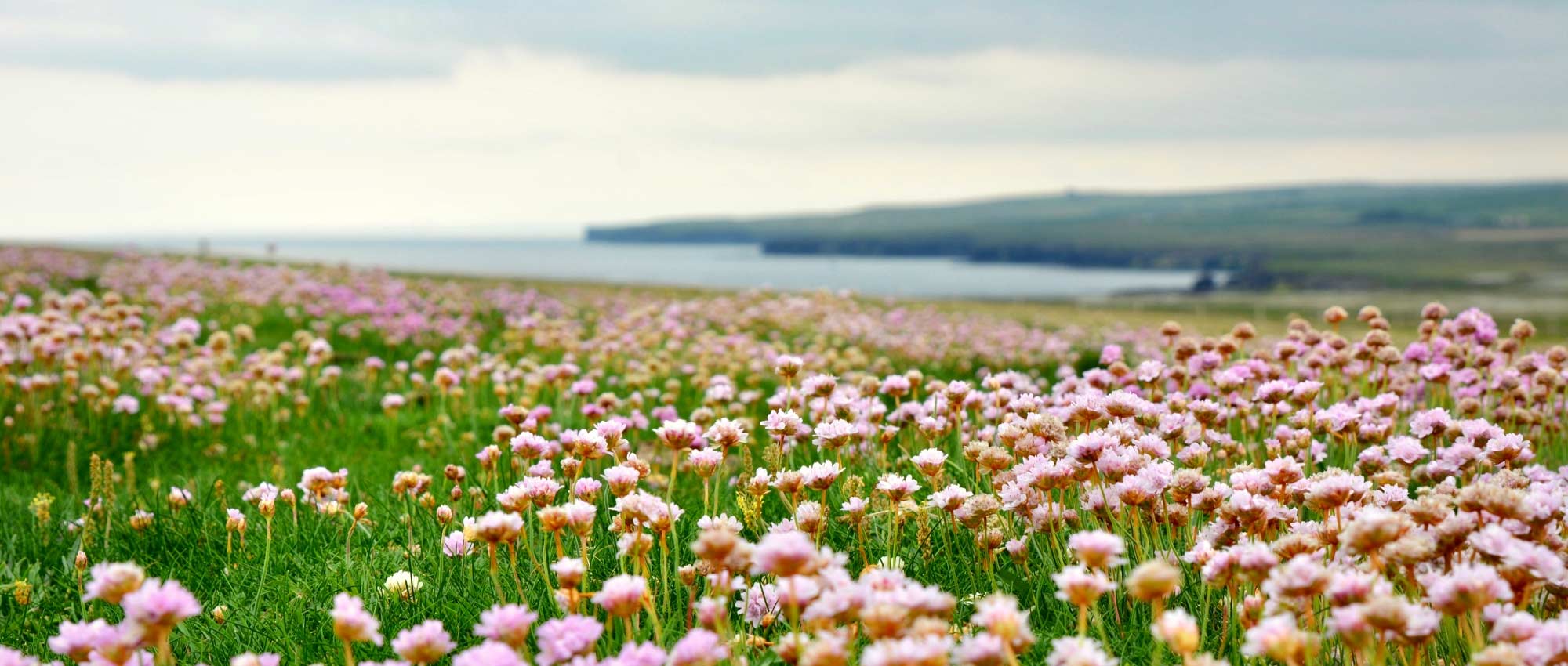
10 perennial plants ideal for a seaside garden
Our selection for creating a coastal garden
Contents
Coastal gardens are appealing for their very mild climate, allowing to grow plants that are not very hardy, in an exceptional setting, sometimes with a lovely view of the sea. However, they are also exposed to salt spray, which scorch plant foliage, to strong winds, which can uproot them, and to poor, free-draining soil. These harsh conditions therefore require a selection of suitable plants capable of withstanding such an environment.
On the coast, plants must be tolerant of salt, sea spray and strong winds. In general, they are fairly low-growing plants with a mat-forming or cushion habit, and deep roots that anchor them firmly in the soil and allow them to seek water and mineral nutrients deep below. Moreover, they generally have small leaves, often grey or silvery, downy, thick and leathery, which limits water loss. Discover our selection of perennials that will help you create a superb coastal garden! And do not hesitate to use the same plants that occur naturally on the coastline in the wild: they are naturally adapted to these particular conditions.
Sea thrift, Armeria maritima
Also called Spanish Thrift, Armeria maritima is a charming perennial with a creeping habit, which does not exceed 30 cm in height during flowering. Flowering begins in May, and the plant then produces erect, rigid stems that bear rounded, globular inflorescences at their tips, composed of small pale pink flowers. Armeria also has fine, linear leaves resembling an herb, which are evergreen. Easy to grow, requires little maintenance and suits rockeries well.
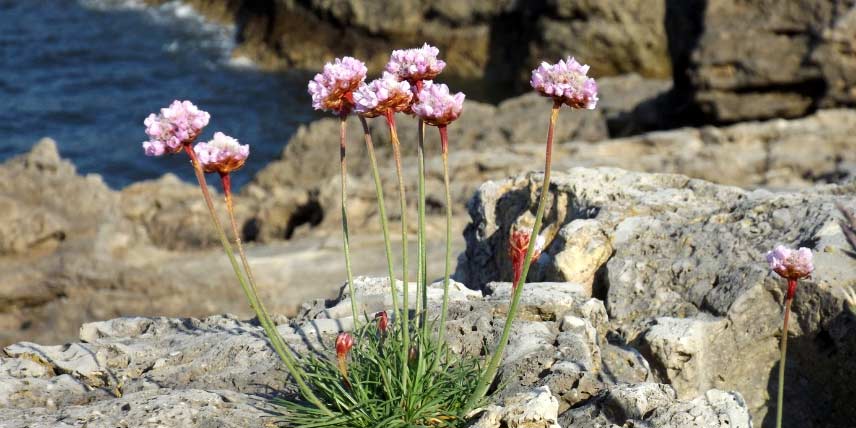
→ For everything you need to know, discover our guide to planting and growing Armeria maritima
Read also
Coastal garden designAgapanthus
Agapanthus are beautiful perennials native to South Africa, producing blue or white flowers, grouped in umbels borne on upright stems above the foliage. The foliage consists of attractive long, strap-like green leaves, which can be deciduous or evergreen depending on species. Agapanthus is appreciated for its modern yet exotic appearance, and its flowering gives it an elegant, graceful silhouette. Some varieties stand out for their very dark, almost black flowers, such as Agapanthus ‘Black Magic’ for example.
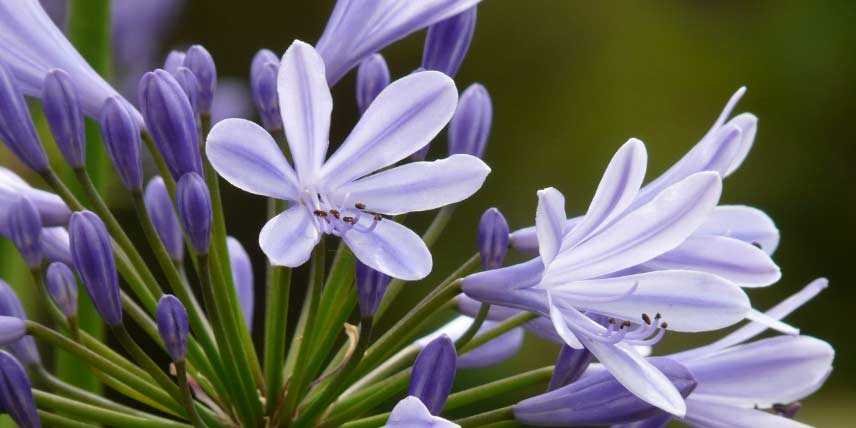
→ Feel free to consult our fact sheet “Agapanthus: To plant, to grow and to care for”
Eryngium maritimum, sea holly
Sea holly is a plant with silvery, prickly foliage, hardy. It also offers metallic-blue flowering in the form of small globular panicles. We appreciate its distinctive colour and graphic form! Sea holly easily finds its place in modern, fairly pared-back borders. It roots deeply thanks to a taproot, which makes it drought-resistant and allows it to remain well anchored in the soil, even in strong winds or on unstable ground. It is naturally present on French coastline and has even been chosen as emblem by the Conservatoire du Littoral.
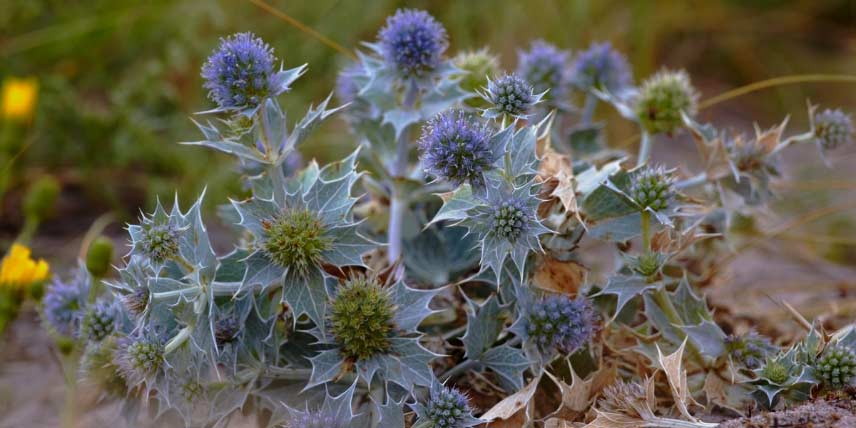
Eryngium maritimum (photo: Michael Apel)
Dusty miller, Senecio cineraria
Senecio cineraria (silver dust) has the distinctive feature of superb grey, downy foliage with a very soft aspect, beautifully lobed. It is a perennial that grows naturally in the Mediterranean basin. It flowers in late spring or summer and displays lovely bright yellow flowering, composed of small flowers gathered in heads. It is very hardy, tolerant of drought, sea spray and wind. You can plant it in borders, rockeries, or even in containers or pots. It is ideal for accompanying other plants with grey-silver tones, or for creating contrasting effects alongside darker foliage!
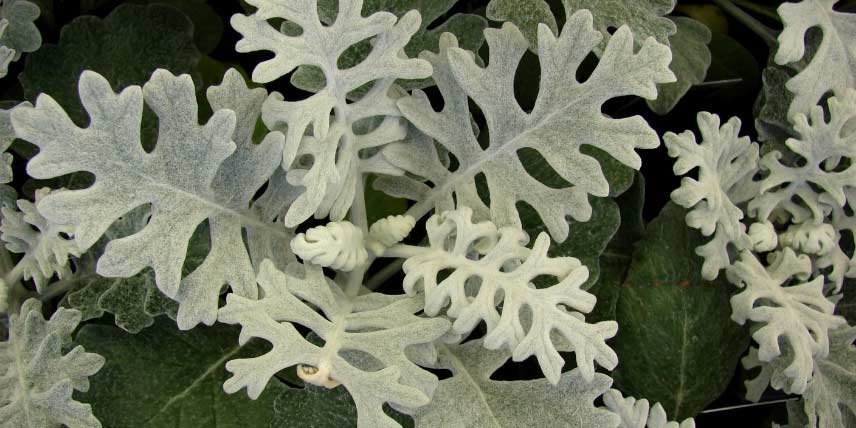
Foliage of Senecio cineraria (photo Forest & Kim Starr)
Delosperma cooperi, perennial ice plant
Originally from South Africa, the Delosperma cooperi is a perennial forming a tapetum of pink flowers, which stays at ground level and does not exceed 10–15 cm in height. It offers a long flowering period that lasts throughout summer, and is perfect for bringing plenty of colour to the garden! Leaves are elongated and fleshy, succulent, and are inserted on creeping stems, which are very spreading. Delosperma is perfectly suited to planting in a rockery or on a low wall, as it gets by with very little substrate… But you can also place it at front of a border, in front of taller plants, or in a hanging basket. It tolerates poor, dry soils well.
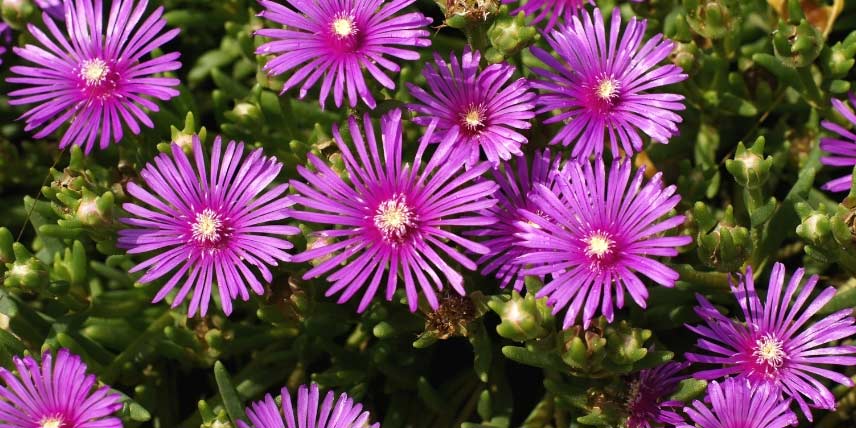
Delosperma cooperi (photo Alexander Klink)
→ To find out all about this plant, visit our factsheet: “Delosperma, perennial purslane: plant and grow”
Sedum spectabile or autumn stonecrop
Also called Autumn stonecrop, Sedum spectabile is a large sedum with an erect habit, very different from small creeping sedums. It produces upright stems reaching up to 50–60 cm in height at most, bearing thick, fleshy, succulent leaves. At the top of these stems appear dense, flattened inflorescences, pink or reddish, sometimes creamy white, depending on variety. Sedum spectabile is a plant easy to grow, requiring very little maintenance. Moreover, it is fairly hardy, able to withstand down to −15 °C. We particularly recommend variety Sedum spectabile ‘Septemberglut’, which offers a beautiful pink flowering.
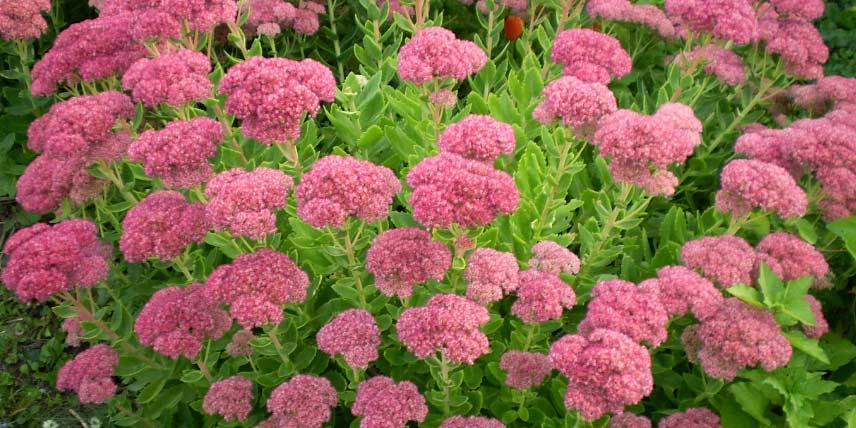
Sedum spectabile ‘Brilliant’
→ Discover the great diversity of sedums in the plant sheet dedicated to them: “Sedum or orpin: how to plant, grow and propagate them”
Lithodora diffusa, gromwell
Lithodora diffusa, also called Grémil diffuse, is a small groundcover plant that does not exceed 20 cm in height, and produces many small star-shaped flowers in spring. Those of the variety ‘Heavenly Blue’ have a superb colour, an intense, deep blue. This lovely perennial also bears small, single, dark green, evergreen leaves. There are also bicoloured varieties with blue and white flowers, which further highlight their star shape. Lithodora is perfect for edging, at the front of a bed, or in a rockery.
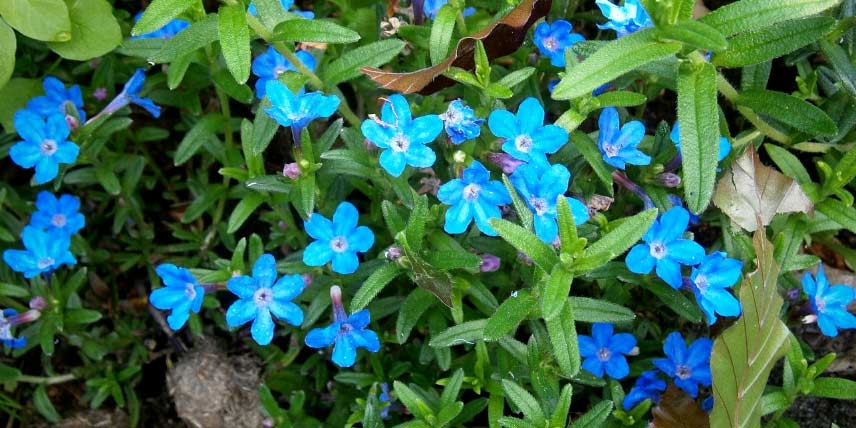
Lithodora diffusa ‘Heavenly Blue’ (photo Meneerke bloem)
Agaves
Ideal for creating an exotic-style garden, agaves impress with their superb rosettes of thick, leathery leaves, each ending in a sharp tip. Leaves can be green, bluish, or variegated with creamy white or yellow. These plants take years to flower, then produce impressive, very tall upright flower spikes and then die. They are said to be semelparous: they flower only once in their lifetime. One of the most widely grown species is the splendid Agave americana, which exists in many varieties. In the garden agaves are prized for their graphic, modern, very exotic appearance. They are particularly suited to the Mediterranean coast.
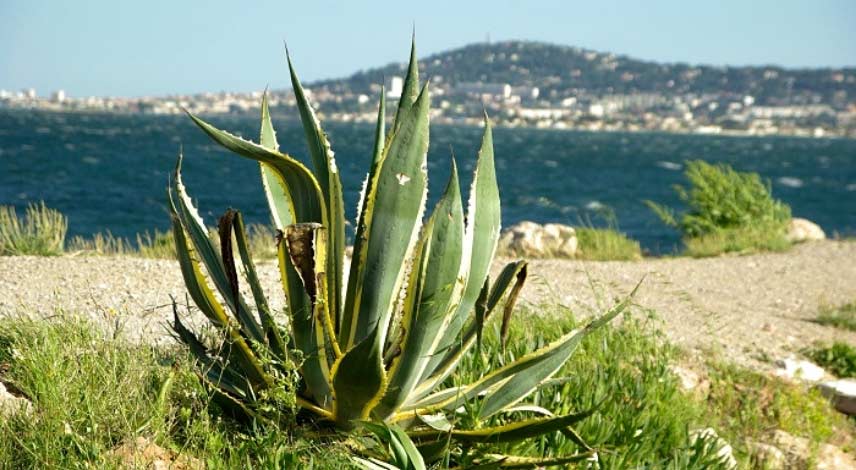
Agave americana ‘Variegata’
→ To learn everything, discover our fact sheet on agave
Helichrysum italicum, Italian everlasting
Italian Immortelle is a perennial plant that grows naturally around the Mediterranean basin, and which offers a very bright yellow flowering in summer. It is also called “curry plant” or “curry herb”, because of its strong scent reminiscent of curry. It grows up to 50 – 60 cm tall, and forms clumps with rather fine silvery foliage. It has medicinal properties, particularly effective against bruises, burns and inflammations. An essential oil can also be extracted from it.
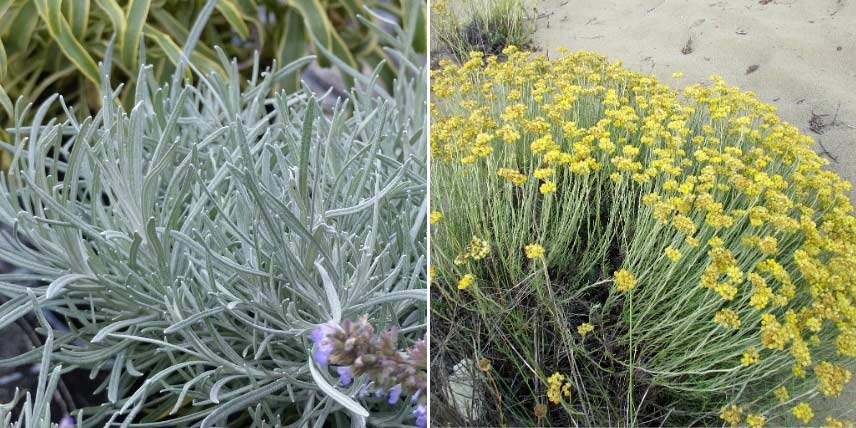
Helichrysum italicum: Foliage and flowering (photo Assianir)
Echium candidans, viper's-bugloss
Echium candidans, or viper’s bugloss, is an imposing plant that offers in spring an original flowering made up of long spikes of blue-violet flowers. It is native to Madeira; in English it is nicknamed Pride of Madeira (the pride of Madeira)! It is also found under the scientific name Echium fastuosum. It is quite impressive, reaching 1.5 m in height, and also has a rather wide, spreading habit. Its stems bear very beautiful elongated, evergreen leaves. It can thrive in poor, shallow, fairly dry soils. It has a short lifespan, but can self-seed in the garden.
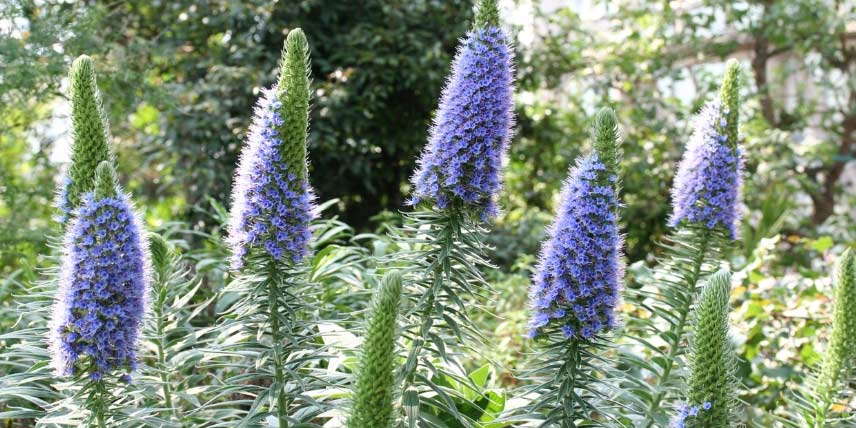
Echium candidans (photo Jean-Pol Grandmont)
Further reading
→ Also discover our article: “Sea-spray-resistant perennials for coastal gardens”.
- Subscribe!
- Contents
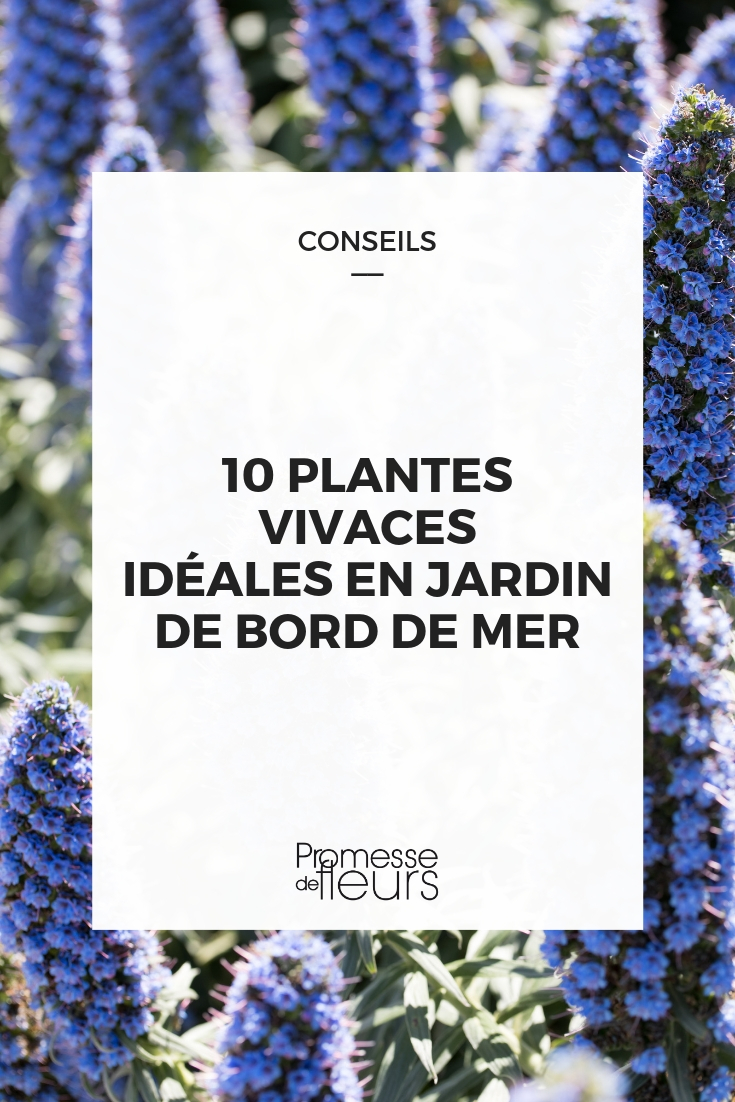































Comments